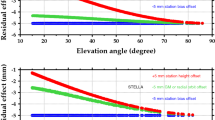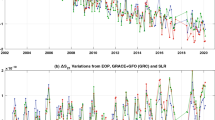Abstract.
Time variations in the Earth’s gravity field at periods longer than 1 year, for degree-two spherical harmonics, ΔC21, ΔS21, and ΔC20, are estimated from accurately measured Earth rotational variations. These are compared with predictions of atmospheric, oceanic, and hydrologic models, and with independent satellite laser ranging (SLR) results. There is remarkably good agreement between Earth rotation and model predictions of ΔC21 and ΔS21 over a 22-year period. After decadal signals are removed, Earth-rotation-derived interannual ΔC20 variations are dominated by a strong oscillation of period about 5.6 years, probably due to uncertainties in wind and ocean current estimates. The model-predicted ΔC20 agrees reasonably well with SLR observations during the 22-year period, with the exception of the recent anomaly since 1997/1998.
Similar content being viewed by others
Author information
Authors and Affiliations
Corresponding author
Rights and permissions
About this article
Cite this article
Chen, J., Wilson, C. & Tapley, B. Interannual variability of low-degree gravitational change, 1980–2002. J Geodesy 78, 535–543 (2005). https://doi.org/10.1007/s00190-004-0417-y
Received:
Accepted:
Published:
Issue Date:
DOI: https://doi.org/10.1007/s00190-004-0417-y




